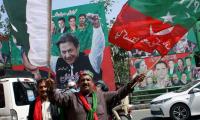On Monday, Prime Minister Imran Khan made ample use of yet another public appearance to count his government’s economic success stories as he presided over the formal launch of a $500 million international bond.
It was a speech that added to several days of an unending chorus from official policymakers, each lining up to claim that Pakistan has effectively turned the corner. But just as more debt (the $500m bond as the latest) is money that has added to Pakistan’s considerable stock of foreign debt which must be paid back eventually, the risk of the surging economic numbers is hard to ignore.
Outside the ruling structure, the latest numbers have been received with a dose of scepticism by independent economists. But, notwithstanding the matter of accuracy, the official numbers must begin losing their relevance at some point, as Pakistan’s multiple challenges haunt the country’s future.
On the external front, amid the imminent withdrawal of US troops from Afghanistan, warnings of a surge in violence across the strife-torn country must not be ignored. The risk of a spill-over into Pakistan and its consequences for a range of matters, including the country’s economic future, are all too real to be left on the side.
More pertinently, however, a continuing crisis of governance and underperformance of ruling structures – including the present one – could easily more than neutralize any real or imaginary gains from a numerical economic upturn.
Anecdotal evidence from across Punjab, Pakistan’s proverbial heartland, the crisis of governance and the failure of Chief Minister Usman Buzdar’s administration to turn things for the better, is widely known. Conditions of daily life across Punjab have already cast a dark shadow over official optimism.
Anecdotal evidence from one district to another speaks of continuingly dysfunctional institutions, ranging from government provided educational institutions and healthcare facilities to policing networks. The prime minister’s emphasis on reviving Pakistan’s agriculture notwithstanding, the mechanisms relevant to supporting farmers have remained effectively redundant for long.
Meanwhile, the recent upturn in the output of some key crops notably wheat are more the consequence of favorable weather conditions than successful policies. And the agriculture sector is far from coming out of its potential crisis zone unless the large cotton crop, which failed in the past year, makes a robust comeback.
Across this sector, the worst challenges waiting to be tackled include Pakistan’s increasingly short water resources which suffer from long-term delays in building new reservoirs and management of existing ones. It is therefore not surprising that consumers at the tail-end of irrigation canals include some who have not seen water supplies for years.
Another key element relates to the once thriving but now dysfunctional extension services, responsible for delivering expertise and guidance for quality inputs to farmers.
Elsewhere too, stakeholders in industries and services sectors are baffled over the official numbers surprisingly surging, in a year punctuated by the fallout from the dreaded coronavirus. But even if the official claims are accepted, compelling questions cannot be ignored over a ‘fast rising economy’ versus an essential reality check.
Across Pakistan, the crisis surrounding ordinary households notably over prices of food commodities, is all too visible. It is here that Prime Minister Khan and his PTI must make a difference, to overcome large patches of scepticism across the country. And if the supply of food commodities has improved following an improvement in output of crops except cotton, the challenge of food inflation then must be embedded in a poorly performing structure of governance all around.
Historical experience within and outside Pakistan suggests the dangerous consequences of premature claims of economic success built on surging numbers, fuelling an ever-widening gap between the rich and the poor.
In parts of Latin America in the 1970s the emergence of large and modern farming estates known as the Haciendas masked underlying poverty that eventually led to armed conflict.In Pakistan, the ‘Dubai chalo’ movement from the early 1970s led many blue-collar workers to the oil rich Middle East. But the subsequent wealth also sharpened the divide across neighbourhoods between the haves and the have-nots.As Prime Minister Khan and his team pat themselves on the back, they must read Pakistan’s economic history to draw precious lessons from the past.
The writer is an Islamabad-based journalist who writes on political and economic affairs.
Email: farhanbokhari@gmail.com
Any progressive society or government will uphold security so that people can utilize their full potential
In Pakistan, we have witnessed erosion of public trust in government institutions
Capability, accountability, and responsiveness don’t quite capture the increasingly important issue of legitimacy
The government can directly influence economic activity through current and capital expenditure
A view of the Supreme Court of Pakistan. — Supreme Court website/FileWhat kind of firewall does the judiciary...
Indian soldiers stand alongside a barbed wire on the Line of Control. — AFP/FileAnti-Pakistan propaganda remains a...







